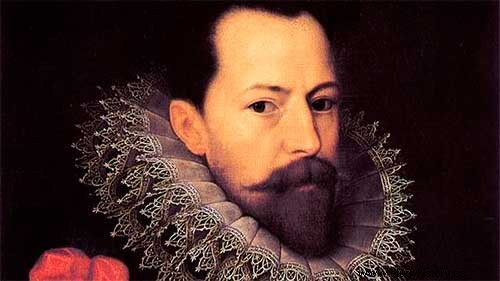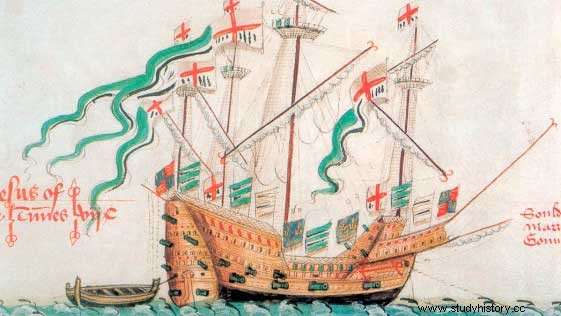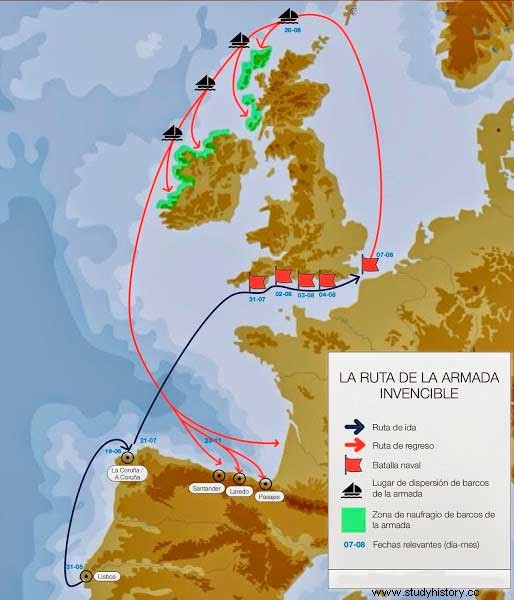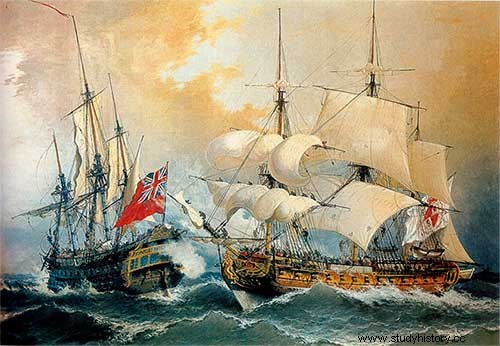The defeat of the Spanish Armada is one of the legendary victories in English history. The English artillery defeated the Spanish fleet albeit only after a fire ship attack scattered the Armada at Calais, and prevented it from escorting the Spanish army across the English Channel.
Invincible Army data
Who: Philip II of Spain sent the Duke of Medina Sidonia (1550-1619) with the "Invincible Armada" against the English queen Elizabeth I, whose fleet was led by Lord Howard of Effingham (1536-1624) and Sir Francis Drake (1543-1596).
How: A naval battle he saw as the English system of sea combat, with the introduction of broadside-firing battle lines, dwarfed Spanish 'galley warfare' tactics.
Where: In the English Channel, from Cornwall to Gravelines, on the Belgian coast.
When: From July 31 to August 9, 1588.
Why: Felipe II tried to invade England with the army of 30,000 men of the Duke of Parma, to put an end to his problems with England once and for all.
Result: A fire ship attack at Calais broke the Armada's formation, the English won at Gravelines, and the surviving Armada were forced to sail around the British Isles to escape.
Background
Until 1585 King Philip II of Spain and Queen Elizabeth I of England had learned to live together. That year Francis Drake raided the Spanish coast while England, now allied with the Dutch rebels, landed 4,000 soldiers in Holland. It was a declaration of war against Spain, if not formal, at least in practice. Parma proposed the landing of 30,000 men of his army of Flanders directly on the Kent coast, while Don Álvaro de Bazán, Marquis of Santa Cruz, advised sending 510 ships and 95,000 soldiers against England directly from Spain. Santa Cruz had taken the Portuguese islands of the Azores (1582-1583) and had fought at Lepanto in 1571 when the Holy League crushed the Turkish fleet. Hesitant and cautious by nature, Philip II chose a compromise solution. He would send the Armada to the English Channel to later escort Parma on the way from the Netherlands. This strategic arrangement would prove to be the Navy's undoing before it even got out of port.
To buy time during the English preparations against the invasion, the famous English corsair (or pirate, as the Spanish called him) Sir Francis Drake went to sea with
22 ships and, on April 19, 1587, he attacked Cádiz, where he burned or captured 36 Spanish ships at anchor, and in May he raided the Azores. Drake's dangerous presence forced Philip to delay the departure of the Armada until the following spring.
Felipe II had named Santa Cruz Commander of the Navy, but the Marquis died in February 1588 in the middle of the preparations. Santa Cruz's position as captain general of the Ocean Sea was occupied by Don Alonso Pérez de Guzmán, 38, seventh Marquis of Medina Sidonia, an expert and efficient organizer who would soon have the enormous project of the Invincible Armada back on track. Whatever the duke lacked in actual combat experience, he made up for with cool tactical and strategic ability, common sense, discipline, and determination. He threw himself with tremendous energy to repair the damage caused by Drake's raids and the chaos that Santa Cruz had left behind. 
The Invincible Armada sets sail
On April 1, the Duke received orders from Philip II:he was to go to Margate in support of Parma, who was to land at Ramsgate and advance down the Thames to take London. Once this was achieved, Philip would force Elizabeth to make concessions. Philip warned Medina Sidonia that the English would try to avoid close combat and would use their superior naval artillery to sink the duke's ships.
On May 30, 1588, the Invincible Armada, numbering 130 ships with 2,400 cannons, 8,000 sailors and 19,000 soldiers, sailed from Lisbon . He certainly looked formidable from afar, though he was much weaker than he seemed. The Spanish treated warfare at sea as an extension of warfare on land. His experience of warfare at sea came from combat with the Turks in the Mediterranean. However, this was disputed with fleets of galleys where the ships were boarded by heavily armed troops, which is why the Spanish carried so many soldiers aboard their ships. The Spanish hoped to approach the English ships, sink their hooks into them, and then seize the enemy ships by boarding.
The English fleet
The English, on the other hand, tried to fight in a completely different way. They had learned to build fast, sleek galleons with plenty of medium and heavy artillery, and could rely on firepower and speed to outspeed, outgun, and outmaneuver the slower, clumsier Spanish ships. The English had several more advantages compared to their enemy. They were fighting in defense of their country against a ruthless would-be invader who wanted to impose his rule and his religion on them. This encouraged them. They also fought in local waters, the English Channel, which they dominated. The Spanish did not know these cold, gray waters well, and, as attackers, they were not as motivated.
The English also had something like professional and specialized crews and officers. Captains were supreme commanders of their ships, while on Spanish ships command was divided between military and naval officers, so it was often unclear who had priority. The English had a well-trained corps of gunners on board, accustomed to loading, firing and reloading their guns quickly and efficiently, despite the lurching of the deck, while the Spanish used their army gunners. The English rate of fire was thus three or four times faster than that of their enemy.
Lastly, the ships themselves were quite different. Not even Felipe II could afford a permanent fleet on the scale of the Armada, so most of the ships had been leased or loaned by friendly people or powers. Most of the Spanish tonnage was not suitable or prepared for a true naval battle and the largest ships in the victualling fleet were not properly armed. In contrast, English ships had been designed specifically as warships, built for fighting in local waters and for fast, intense close-range combat. In 1588 the English had 24 newly built or outfitted ships in the Royal Navy, and to this number could be added privateers and merchant ships. In total, the English navy, under the command of Charles, Lord Howard of Effingham, numbered 105 ships, and the bulk of Howard's fleet was anchored at Plymouth . At 52, Howard had, in fact, little experience in sea combat or in high command, although his subordinates, such as Drake and Frobisher, had gained much from him in their many privateering raids against the enemy. Drake had discovered, from various sources, that the Spanish Armada was going to sail along the English Channel and try to neutralize their English enemy before Parma landed in England.
So far everything was going well from the English point of view; however, they had no idea where Parma was going to land. Elizabeth was convinced that she would land in Essex and she stationed her favorite Robert Dudley, Earl of Leicester, there with the bulk of the English army (14,000-20,000 men). This left only 4,000 ill-equipped recruits to defend the Kent coast, where, in fact, Parma's veterans were going to land.

First day
After a delay in La Coruña due to a storm that temporarily dispersed the huge fleet from 19 to 21 July, the Armada slowly crossed the Bay of Biscay and on 30 July entered the English Channel. During the night of July 30/31, Howard's fleet, numbering 64 ships, crossed the Armada rout, while Drake's squadron remained close to shore. Medina Sidonia formed his vast Armada into a huge crescent, the center of which he commanded (90 ships). The left flank (20 ships), was under the command of Don Alonso Martínez de Leiva and the right flank (also 20 ships), under Don Juan Martínez de Recalde. The entire battle formation stretched about 2 miles . It was an impressive and terrifying sight.
Since there had been no formal declaration of war between England and Spain, Howard sent the Defiance (Desafío ) to fire a symbolic shot at the approaching Armada. This was the signal for the start of the fight. As Howard's fleet prepared for battle, it was the Spanish's turn to fret, as the English ships turned in a wing, or line, formation. It was a new flexible system of presenting battle at sea, attacking the enemy with a broadside. The English avoided all close contact with the Spanish ships, since these were full of armed men ready to act. In close combat, the English, armed with light weapons, had little chance.
More encounters
The next day (August 1), Don Pedro de Valdés, in the damaged Nuestra Señora del Rosario , which had been abandoned by the rest of the Invincible Armada, was forced to surrender to Drake aboard the Revenge. During the previous day's fighting some of the Spanish captains had wavered in holding their positions in the rigid fighting formation and in view of this Medina Sidonia ordered that any commander who broke ranks be mercilessly hanged. Later he divided his command:he would lead the vanguard and Leiva would occupy the rear, and, to calm the spirits of his crew and officers, he formed two strong combat groups with the largest and best-armed ships.
On August 2, when the Armada was west of Portland Bill, Howard attacked again, and the British found, however, that his fire had little effect. They fired 500 volleys at the San Martín without causing significant damage.
Howard gave up the fight because his ships were running low on ammunition, noting that the Armada seemed, after all, invincible. In the afternoon, Medina Sidonia considered the possibility of penetrating the Solent to capture Portsmouth and use it as a base. Howard was determined to prevent it and divided his fleet into four squadrons commanded by himself, Drake, Hawkins and Frobisher. While the other three squadrons held off the Spanish Armada, Drake emerged into the English Channel, turned and attacked unexpectedly. The British forced the Armada to abandon its attack on the Solent, and it drifted back toward the channel. A Spanish victory turned into a crucial English success. However, the Armada continued unmolested for two more days, arriving in Calais on the afternoon of August 6.

fire ships
Calais was a dubious haven for the Spanish, as the harbor was shallow and open. However, in France's ongoing religious civil war between Catholics and Protestants, the port of Calais was in the hands of the former, and the French governor was a fervent Catholic who welcomed the Armada with open arms. That same afternoon, the Parma courier arrived in a pinnace from his headquarters with the disheartening news that he would not be ready for six days. Medina Sidonia realized that the English and their Dutch allies, with 140 ships hovering off the coast, were not likely to give them that much time.
His hunch was correct, as Howard had called a council of war aboard his captain, the Ark Royal, on the morning of August 7, where it was decided to send about eight fireships against the Armada at anchor. Howard hoped to sow confusion and disorder, thus allowing the English to close in point blank and blow up the Spanish ships. His ruse went as planned. Medina Sidonia had suspected that the English would launch an attack with fire ships and posted sentinels, so that when the attack was launched, during the night of August 7-8, two of the English ships were intercepted and ran aground. There were six left, who passed. The English had loaded the cannons of the ships with double charges, so that the explosion, the smoke and the fire were tremendous, sowing panic and fear. Most of the Armada captains cut the cables in a mad, thoughtless flight to get away and save their hides, despite the Duke's orders to keep their anchors and return to their previous positions once the attack was over.
At dawn on August 8, the duke had only his captain and four escort ships to protect her. Gradually the ships returned, with the galleons heavily armed to protect the rear of the scattered Armada as it regrouped. The harsh reality, however, was that the English had them where they wanted them. They could finally use their superior firepower at close range, to devastating effect.
The Battle of Gravelines (August 8) was held in the sandbar-filled waters between Gravelines and Ostend, and lasted nine hours. The Saint Martin she received 200 hits, suffered serious damage and began to leak, while hers, her Portuguese twin, the San Mateo , was riddled by the English hits. Both ships ran aground between Nieuwpoort and Ostend, where they were captured with their crews by the Dutch. Two more ships, including the Gran Grifón, ran aground, while another, the María Juan, sank:the only one that would.
Aftermath
Among the Spanish there were 1,000 killed and 800 wounded, and morale sank. Medina Sidonia made desperate efforts to rally his ships by signaling, and then rallied his remaining captains. They failed to convince him of the reasons why they had not returned to the Navy, and he ordered the traitors to be hanged. However, all were pardoned except one, Don Cristóbal de Ávila, who was hanged and his body was later displayed in a pinnace to restore order and discipline.
The Invincible Armada had lost the battle against the English and now, with discipline restored, undertook the arduous journey around the British Isles back to Spain. It was a measure of the leadership of Medina Sidonia and the strength and resistance of his men that so many ships came back.

